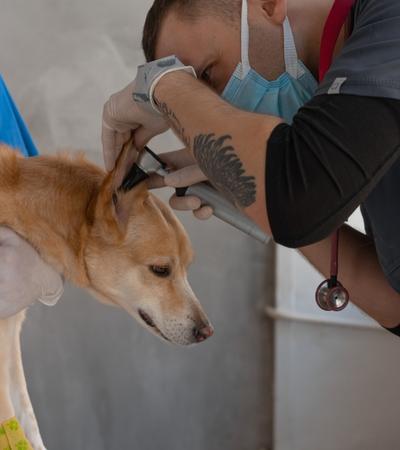For most of us, yeast is associated with baking bread. However, for your pooch, it can be something not quite so nice. A dog ear yeast infection can spring up for a number of reasons.
But, would you know how to spot, prevent, or even treat one?
This is why we’ve put together a complete guide, to provide you with the details on symptoms, causes behind this complaint, and should your bow-wow be suffering — how to cure a dog yeast infection.
Yeast is a fungus that produces spores, which you can find on your dog’s skin at all times, usually in very low numbers. However, these spores can multiply into excessive numbers. When this happens, it becomes an infection.
As it is an inflammatory skin condition, it will thrive in humid areas of the body such as skin folds, paws, and ears. Without treatment, dog ear yeast infections rapidly worsen and cause extreme discomfort.
You may find your dog suffers more from yeast allergies if they have other conditions such as diabetes, cancer, thyroid problems, reduced immune systems, and damaged skin issues. This is because their skin’s resistance is lowered — meaning the small traces of yeast already present on their skin will spread with little effort.

Some pet parents have suspicions of what may trigger dog ears yeast infection. Yet, if you have no idea, here are some of the most common driving forces behind them.
Breed
Unfortunately, some dogs are prone to developing yeast infections based on their breed and genetics. Body traits such as excessive folds in the skin lead to an increased risk.
Basset Hounds, Chihuahuas, Bulldogs, Pugs, Spaniels, Poodles, Lhasa Apsos, Labradors, and German Shepherds are among the pooches known for their susceptibility to yeast infections.
If your tail-wagger is likely to suffer, chat with your vet to discuss ways you can prevent flare-ups from occurring. And, keep their coats clean and dry after any outdoor activities.
Allergies
Dogs can develop allergies to a variety of things — seasonal pollen, food, and even other animals. All of which can lead to a yeast allergy in dogs.
Much like humans, allergies are related to the immune system. Some bow-wows are more sensitive than others and can’t tolerate what we would deem as innocuous matter. This, in turn, triggers a negative response and manifests into an allergy.
Antibiotics
If your furry friend has been on a course of antibiotics, it could be adding to their yeast infection issues. Your dog’s skin is naturally covered in good bacteria and small traces of yeast.
However, the inclusion of antibiotics can disrupt the natural balance and lead to overproduction — increasing yeast and bacteria on their skin. As a result, the opportunity for dog ear yeast infections multiplies for your pooch.
Steroids
If your fur-baby suffers from allergies that are tricky to manage, your vet may prescribe steroid medications to help with their treatment. However, as mentioned, these conditions are caused by an overreaction of the immune system. Steroids weaken this biological barrier. Hence, they will be more vulnerable to yeast infections.
Ensuring your woof woof follows a healthy diet contributes towards a well-functioning immune system. This is one way to help them fend off germs naturally and prevent pesky yeast infections in the future.
Moisture
If your dog has longer, floppy ears, then you will be all too aware of its ability to trap and hold onto just about anything.
However, the delicate environment within your dog’s ears can be thrown off very easily. Trapped moisture within can generate hot and humid conditions — conditions that yeast infections thrive in.
Excessive moisture can be created in your dog’s ears from exercising in a humid climate, swimming, or even too much bathing.

Dog ear yeast infections can be easily diagnosed with a few simple checks. Here’s a run-through of the main offenders:
Redness/Irritation
Most commonly, you will see redness extending onto their outer ear, as well as the inner parts. If your dog has a lot of hair in and around this area, it may appear matted and greasy with a brown discharge and a slightly musty smell.
Itchiness
Itchy, and sore-looking skin is typically the first telltale sign your pooch is suffering from some form of irritation in its ears. Your dog may shake their head or frequently scratch their ears.
Although these are key symptoms in most ear-related issues for any dog, you should seek medical advice to determine the exact cause. This could also be a sign of something being trapped within their ear canal.
Odor
As your dog ear yeast infection progresses, you may start to pick up on a smelly aroma coming from their ears. Many doggy parents report the odor to be similar to a cheesy or musty smell.
However, it could be something less sinister — like not cleaning your dog’s ears regularly enough.
Discharge
We all know that wax in your pup’s ears is common and normal. Yet, when it comes to yeast infections you may notice a red or brown tinged discharge. It will still appear waxy, but when coupled with the other mentioned symptoms, it more than likely points towards a dog ear yeast infection.

Not only are ear infections uncomfortable, if left untreated, complications can arise and you may find it becomes incredibly painful or even worse for your dog.
Preventing a yeast infection is key to making sure your pup is healthy. Although it can be hard to avoid these issues if your tail-wagger has underlying health issues that make yeast infections a regular occurrence.
Some of our top tips to reduce the risk of dog ear yeast infections include:
- Keep ears clean and dry.
- Use an ear cleaner with a drying agent.
- Administer supplements and a special diet.
- Monitor the insides of floppy ears.
Typically dog ears yeast infection treatment differs from a bacterial infection and if ignored will only get worse, causing more issues for your fur-baby. With the discomfort and pain, you may find it hard to touch or look inside your pooch’s ears.
Thankfully dog ear yeast infection treatment is fairly simple when caught early on and can be managed with prescribed medicated ear drops and a cleaner.
Dog ear fungus treatment drops will contain specific medication to kill the yeast and prevent it from spreading any further — as well as ingredients to soothe the discomfort and make your pup more comfortable. Anti-inflammatory medication may also be used depending on the severity and discomfort your woof woof is displaying.
Occasionally your bow-wow may need to be sedated for a deep clean to take place. However, this is only in extreme cases, where a dog ear drops yeast infection treatment can’t alleviate the complaint alone.
Sometimes a yeast allergy in dogs is avoidable — by keeping their ears clean and dry at all times. This can be done using specialized dog ear yeast infection treatments.
Bear in mind, some breeds are more likely to suffer, as are fur-babies with medical complaints. And, while allergies are a top offending trigger, even medication can provoke an infection.
If for whatever reason, your pooch picks up a dog ear yeast infection frequently then hopefully this guide provides everything you need to know to swiftly deal with it.
“How Do You Treat Yeast Infection in Dog’s Ears?”
Your vet will be able to prescribe an antifungal treatment in the form of drops, ointments, or a cream that will kill the yeast infection and soothe the symptoms that come with it.
“What Food Can Cause a Dog Yeast Infection?”
Many pet parents don’t realize that excessive amounts of sugar and grains in a dog’s diet will feed the yeast already present on your dog’s body and ears. This will lead to an overgrowth and yeast infection.
“How Can I Prevent Dogs’ Ear Yeast Infections?”
Most vets recommend you clean and dry your pooch’s ears after any contact with water from a bath or swimming. They can also check for any underlying allergies or health problems that may lead a pup to experience recurring infections.
“What Does Yeast Infection in Dogs Ears Look Like? “
If your dog is suffering from a yeast infection their ears will look red and they may have a sticky discharge that has an unpleasant smell.



